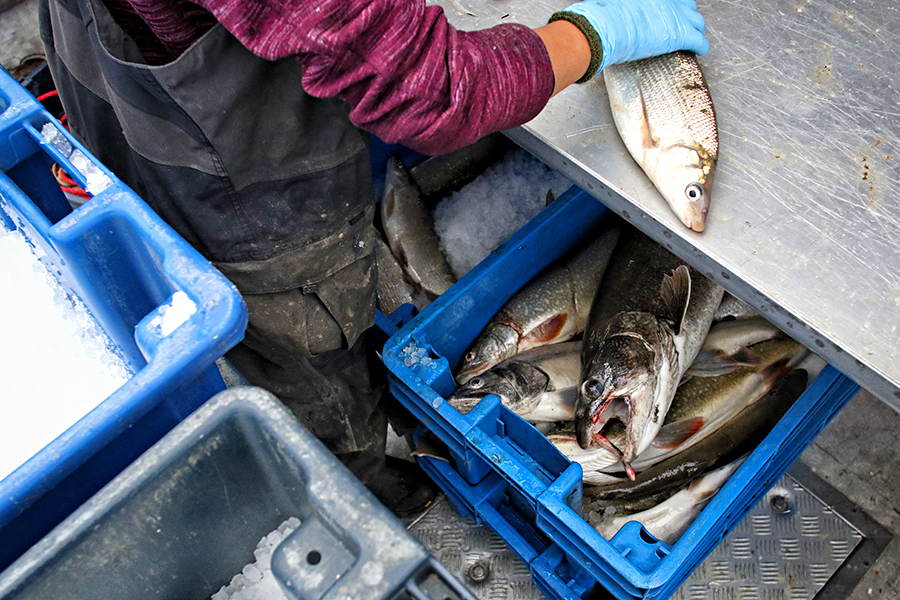UM Bio-Station Receives Grant to Study How Flathead Fish and Mercury Mix
The aggressive removal of invasive lake trout from Flathead Lake is altering the aquatic food web — but should it concern those bringing fish fillets home from the food pantry?
By Tristan Scott
There’s plenty of evidence to suggest that incorporating fish into one’s diet packs a nutritious punch, with high concentrations of omega-3 fatty acids benefiting both body and brain.
But certain types of fish can contain hazardous levels of mercury and other toxins, leading to consumption advisories from public health agencies instructing pregnant women and children, for example, to limit their intake of piscatorial delicacies, such as tuna.
In Flathead Lake, where mercury enters the aquatic food web through atmospheric deposition and gets stored in the muscle tissue of top-level predators like invasive lake trout, years of aggressive suppression efforts to reduce the population and boost native trout numbers has prompted inevitable changes in the aquatic food web, which researchers with the University of Montana’s Flathead Lake Biological Station at Yellow Bay are attempting to better understand.
To tighten their grasp on those questions lurking below the surface, scientists applied for and received a grant through the U.S. Environmental Protection Agency (EPA) to monitor the bioaccumulation of methylmercury in lake trout, as well as other species like mountain whitefish, and to see whether the consumption of fish through food-pantry distribution on the Flathead Indian Reservation warrants a greater need for public health education.
“It’s our assumption that lake trout and other fish species will reveal changes in methylmercury accumulation, and perhaps based on that the Tribes will want to develop additional consumption guidelines,” Nanette Nelson, a research economist at the Biostation and one of the recipients of the EPA grant money, said.
Nelson and her colleagues, Bob Hall and Erin Sexton, are joining forces with the Confederated Salish and Kootenai Tribes’ Natural Resources Department, as well as the Salish Kootenai College, with the aim of answering two questions: How will the removal of lake trout affect methylmercury concentrations in other fish in Flathead Lake; and does access to lake trout at local food pantries result in beneficial or potentially negative health outcomes?
The research project was announced Sept. 16 by the EPA, which distributed more than $2 million to 14 organizations, universities and government agencies in Washington, Oregon, Idaho, and Montana. The Flathead Lake Biological Station received $128,992 to conduct the monitoring surveys and sampling plan, as well as to conduct face-to-face intercept surveys of tribal members using the food pantry, which distributes lake trout and whitefish fillets harvested through the suppression program.
In 2013, the Confederated Salish and Kootenai Tribes (CSKT) approved an aggressive strategy to reduce the number of nonnative lake trout in Flathead Lake, seeking to reduce 75% of adult specimens through gill netting, commercial harvests and fishing derbies.
Two years ago, the CSKT Tribal Government approved the incorporation of the nonprofit, tribally owned Native Fish Keepers, Inc., which has begun selling wild-caught fillets of lake trout and whitefish caught in the Tribes’ gill-netting operations, as well as fish harvested during the spring and fall Mack Days, a biannual fishing derby hosted by the tribes
With an estimated 1.5 million lake trout in Flathead Lake, the Tribes’ goal is to remove 143,000 annually in order to begin seeing a reduction in the overall population. Last year, angling and netting combined removed about 100,000 lake trout. In its 18-year history, Mack Days has removed approximately 800,000 lake trout.
Under current consumption guidelines, which were updated in 2014, CSKT recommends that no one eat lake trout that are 30 inches and longer because those fish are more likely to contain higher levels of methylmercury. The current recommendations vary for children and women of child-bearing age, and for adult women past child-bearing age and all adult men.
“The recommendation is not for people to stop eating fish, we just don’t want them eating heavily contaminated fish,” Nelson said. “Lake trout are part of a healthy diet, but people need to know which lake trout they’re eating. It’s tough because you’re weighing the health benefits of eating fish against the risk of excess exposure to methylmercury.”
The EPA grants are the first to come out of the Columbia River Basin Restoration Funding Assistance Program, established by Congress in 2016 as an amendment to the Clean Water Act to address water quality issues by reducing pollution, including toxins that can accumulate over time in water, sediment and fish tissues.
Nelson said project results, which will require a minimum 15 months to ascertain, would be shared with the Tribes who will ultimately determine the use of the newly acquired data. One possibility might be the development of consumption guidelines for additional fish species, depending on research results, she said.
“Our project will culminate with a half-day workshop that will assemble tribal natural resource managers, health professionals and decision makers to develop a plan on how best to use the newly acquired data to benefit both human and ecosystem health,” Nelson said. “We don’t want to direct what the Tribes do next in any prescriptive way. We want to present our findings to the Tribes and collaborate with natural resource experts and people interested in food sovereignty about how to move forward.”
For more about the Columbia River Basin Restoration Program, as well as to read summaries of each grant recipient’s work, please visit: https://www.epa.gov/columbiariver/columbia-river-basin-restoration-funding-assistance-program.